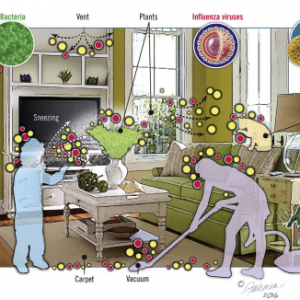I love the idea behind this: And see the associated story in AL.Com by Lee Roop Scientists study the microbiome – the bacteria, viruses and fungi – living in an Alabama high school. Basically this is a partnership between Hudson Alpha and a local school on doing the microbiome of their classroom. Though I would note …
Finally got around to reading “Impacts of Flood Damage on Airborne Bacteria and Fungi in Homes after the 2013 Colorado Front Range Flood” from the labs of Shelly Miller and Noah Fierer. The massive floods in 2013 provided the researchers with an opportunity to examine the lingering effects of flood damage, even post remediation. Ideally …
By Amanda Makowiecki 1st Year Mechanical Engineering PhD Student Miller Research Group, University of Colorado Boulder Researchers at the University of Oregon recently published a paper examining the connection between architectural design and microbial diversity in our buildings (Kembel et al. 2014). Although occupancy type was identified as the strongest predictor of microbial variation, several …
The spread of antibiotic resistance traits is an ongoing and important issue that is poorly studied. This PLoS One study by Lerma et al. is the first to use a culture independent approach to characterize antibiotic resistance traits in the total microbiota present in a goat and lamb slaughterhouse. Lerma et al. found that tetracycline resistance genes (tetA and tetB) and Sulfonamide …
We publish a newsletter every month here at microBEnet. And I thought it would be good to also publish to the blog the various summaries and roundups from the newsletter. Past newsletters are archived here. Here are some of the highlights from this latest newsletter. MicroBEnet Blogs A summary of the recent topics posted on microBE.net …
On October 7th and 8th 2014, we held a workshop at the University of California, Davis entitled Animals in the Built Environment. The aim of this workshop was to catalyze the study of the microbiology of built environments where animals live by bringing together experts in animal health, building science and microbiology to discuss why these systems are …
The idea for GenomePeek began two years ago when I was working with Karl Klose, Liz Dinsdale, and Rob Edwards to assemble a P. salmonis genome that was being particularly difficult, even though we had 9 gigabases of sequencing. To check whether it was a single isolated genome I pulled out all the 16S reads …
Over dinner the other night, a friend brought up ongoing public health efforts to get people to stop washing raw chicken because it spreads Campylobacter onto kitchen surfaces. I have to confess that I have been washing, drying and salting a raw chicken nearly once a week for years, following Judy Roger’s (Zuni Cafe) fabulous recipe …
We are organizing a workshop to catalyze the study of the microbiology of built environments where animals live. The workshop is scheduled for October 7th and 8th at UC Davis. Our aim is to bring together experts in animal health, building science and microbiology to discuss why these systems are worthy of study and how research in this …
I’ve been thinking a lot about concrete lately. Mainly, I’ve been thinking about the lack of concrete here in Boulder compared to Houston, where I lived for four years until May this year. As I’m training for a half-marathon, my knees are particularly grateful for the lack of concrete they’ve experienced of late. We’ve also …
